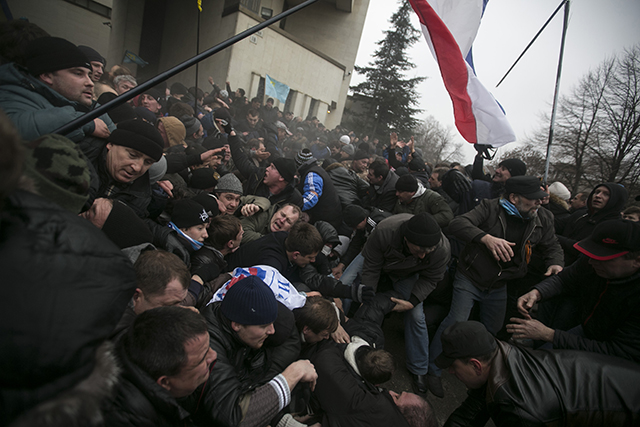Today, unknown forces wearing uniforms took over the Parliament, Council of Ministers and Justice Ministry buildings in the Autonomous Republic of the Crimea, a majority-Russian speaking area, which has belonged to Ukraine since 1954. There are reports of similar forces controlling the port city and the resort of Yalta. It appears that a Russia-backed operation to detach the Crimea from Ukraine has begun.
What Does Operation in the Crimea Mean?
As the forces taking action in the Crimea appear to be Russian or Russian-supported, these actions may violate the 1994 Budapest Memorandum that Russia is a party to. The Memorandum guaranteed territorial integrity of Ukraine upon it giving up nuclear weapons, and it is co-signed by Russia, the U.S. and U.K. Moreover, Russia appears to be in violation of its Status of Forces Agreement with Ukraine on its naval and military forces in the Crimean port of Sevastopol, which confined the Russian troops to the Russian naval base there.
On February 26, Russian President Vladimir Putin ordered a large-scale military exercise in the western and central regions of Russia, which will take place in close proximity to the Ukraine border. The timing of the drills is alarming as Russia-backed Ukrainian President Viktor Yanukovich was ousted from his presidency just last week and is reportedly hiding in Russia. The new Cabinet, headed by Arseny Yatsenyuk, was announced Wednesday at the Maidan Independence Square.
What is Russian military up to?
Russian Defense Minister, Sergei Shoigu, said that the military drills are being held to “test combat readiness of troops in dealing with crisis situations that threaten the military security of the country” and are not related to the Ukrainian revolution. Yet, the alarms have to go up at NATO and elsewhere as the massive drills will continue through March 3. According to Deputy Defense Minister Anatoly Antonov, they will involve “150,000 troops, 90 aircrafts, 120 helicopters, 880 tanks and 1,200 pieces of military hardware” – enough to overwhelm the weak and underfunded Ukrainian military, especially in the Crimea. There is a danger that Russia might try to use force to occupy and detach the strategically important Crimea peninsula – similar to what it did in Abkhazia and South Ossetia during the August 2008 Russo-Georgian war.
Why is this dangerous?
The drills may suggest a preparation of Russian military invasion of Ukraine. As Ukrainian opposition, including the ultra-nationalist “Right Sector” took over Kyiv and toppled Yanukovich’s regime, official Moscow reacted with anger, calling into question the new Ukrainian government’s legitimacy. Also, on February 6, a top Kremlin official, Sergey Glazyev, announced that Russia might intervene in Ukraine to maintain its security. The eastern and south parts of Ukraine are Russian-speaking and pro-Russian, and are opposed to the new government in Kiev.
What is the political dynamic in Ukraine?
One of the first steps the new government took after the revolution was to ban the use of Russian as an official language in Russian-speaking regions in the East. This did not resonate well in eastern Ukraine, causing violent clashes between pro-Russian and pro-Maidan supporters in the Crimea.
What the U.S. and NATO allies are doing?
Ukraine is currently in a severe political and crisis – the worst in Europe since the Yugoslav war. The U.S. and its NATO allies are taking seriously the possibility of a Russian armed operation against Ukraine. Secretary of State John Kerry has warned Moscow not to intervene militarily. The U.S. and European allies are keeping pressure on Moscow not to use its military force. No one desires a war in Europe.
NATO issued a harsh statement on Thursday, February 27:
“NATO has a long-standing partnership with Ukraine. Today we made clear that NATO stands ready to support democratic development, defence reforms, military cooperation and democratic control over the security sector,” said NATO Secretary General Anders Fogh Rasmussen.
He stressed that “we wish to continue our engagement and confirm our support to Ukraine on the path of democratic and inclusive reforms.” …
“This morning’s action by an armed group is dangerous and irresponsible. I urge Russia not to take any action that could escalate tension or create misunderstanding I urge the new Ukrainian leadership to continue its efforts to establish an inclusive political process that reflects the democratic aspirations of the entire Ukrainian people. And I urge all parties to step back from confrontation, refrain from provocative actions and return to the path of dialogue. There is a need for all concerned to take a responsible stance and to work for stability,” he said.
Ukrainians deserve a chance to put their house in order. Secretary Kerry already pledged $1 billion in emergency U.S. loan guarantees to help Ukraine’s new, temporary government delay economic meltdown. In addition, as The Heritage Foundation suggested in an Issue Brief published this December, the U.S. should support an economic rescue package predicated on a massive reform planned and implemented in cooperation with international financial institutions, as well as an Association Agreement with Europe. After all, Yanukovich was toppled for not signing it.
The U.S. is helping the Ukrainian people and its leaders to achieve its goal of a renewed, prosperous, democratic, and independent Ukraine.
—Ariel Cohen, PhD, is Senior Research Fellow in Russian and Eurasian Studies and International Energy Policy in the Douglas and Sarah Allison Center for Foreign and National Security Policy, a division of the Kathryn and Shelby Cullom Davis Institute for International Studies, at The Heritage Foundation.
























